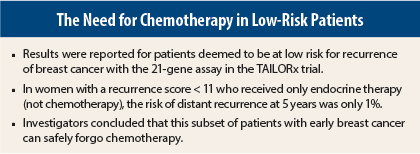The long-awaited first results are in from the TAILORx study, showing that patients with early breast cancer considered at low risk for recurrence can forgo chemotherapy and be treated with endocrine therapy alone.1
“Women with axillary node-negative, estrogen receptor–positive, HER2-negative breast cancer and a recurrence score less than 11 have a 1% risk of distant recurrence at 5 years with endocrine therapy alone,” according to Joseph A. Sparano, MD, of Albert Einstein College of Medicine in Bronx, New York. “This population may be spared chemotherapy.”
TAILORx (Trial Assigning Individualized Options for Treatment) is the first prospective evaluation of the 21-gene assay (OncotypeDX). Although the assay is widely used, it does not provide clear guidance on the optimal treatment of the intermediate-risk group. The trial was primarily designed to determine whether adjuvant chemotherapy produced clinical benefit in patients with a midrange recurrence score of 11 to 25. These patients were randomized to chemoendocrine therapy (standard arm), or endocrine therapy alone (experimental arm). Patients with a recurrence score > 25 were assigned to chemoendocrine therapy, based on prior studies showing substantial benefit from chemotherapy for this subgroup. Patients with a score < 11 were assigned to endocrine therapy alone, since prior studies showed good outcomes for this group when treated with endocrine therapy alone. A score of 11 was set as the cutpoint for randomization in this trial because this may be associated with a risk of distant recurrence as high as 10% at 10 years—a threshold above which chemotherapy would typically be recommended.
At the 2015 European Cancer Congress, investigators reported the results for the low-risk subset (recurrence score < 11). Data on the intermediate-risk (recurrence score 11 to 25) and high-risk (recurrence score > 25) groups will be reported in the future. Results were simultaneously published online in The New England Journal of Medicine.2 (See related article for more on the published report.)
The recurrence scores used in the TAILORx study are different from those generally applied in the widely used assay, which are recurrence score < 18 for low-risk designation, recurrence score of between 18 and 30 for intermediate-risk designation, and ≥ 31 as high-risk designation. Investigators wanted to minimize the potential for undertreatment of the participants enrolled in the trial, and so they tightened the definitions of risk.
TAILORx Details
The TAILORx study involved 10,253 women with hormone receptor–positive, HER2-negative, lymph node–negative breast cancer. The 16% of women with a recurrence risk score considered low (< 11) received 5 years of treatment with an aromatase inhibitor (59%), tamoxifen (34%), tamoxifen followed by an aromatase inhibitor (1%), ovarian suppression plus other therapy (3%), or other/unknown therapy (3%). Six patients received chemotherapy (one of whom had a recurrence).
Among the 1,626 women deemed at low risk (recurrence score < 11), the following 5-year outcomes (rates) were observed: 93.8% invasive disease-free survival; 98.7% recurrence-free interval; 99.3% distant recurrence-free interval (ie, freedom from metastatic disease); and 98.0% overall survival. There were 88 cases of either invasive cancer or death during the 5-year study period, Dr. Sparano reported.
A multivariate analysis found that tumor grade was the only covariate that showed a significant association with any endpoint examined, specifically recurrence-free interval (P = .02).
“Recurrence rates were low, irrespective of histologic grade,” Dr. Sparano noted. “Recurrence risk was not significantly impacted by age or tumor size…. Second primary cancers exceeded cancer recurrence at 5 years.”
In addition, he noted that clinical characteristics could not reliably distinguish patients with a recurrence score < 11 vs 11 to 25. Interestingly, many of the patients would have been treated with chemotherapy had clinicians considered only their clinical characteristics.
“This prospective clinical trial provides the highest level of evidence supporting the clinical utility of the 21-gene assay in this setting and confirms expert-based clinical guidelines that the recurrence score should be used to risk-stratify and assign adjuvant chemotherapy,” Dr. Sparano concluded.
Studies that will be informative include the analysis of the TAILORx population with a recurrence score of between 11 and 25; the RxPONDER and OPTIMA studies of node-positive disease with a recurrence score ≤ 25; and the MINDACT trial, which is testing other gene-expression assays. ■
Disclosure: Dr. Sparano reported no potential conflicts of interest.
References
1. Sparano J, Gray R, Zujewski JA, et al: Prospective trial of endocrine therapy alone in patients with estrogen-receptor positive, HER2-negative, node-negative breast cancer. 2015 European Cancer Congress. Abstract 5BA. Presented September 28, 2015.
2. Sparano JA, Gray RJ, Makower DF, et al: Prospective validation of a 21-gene expression assay in breast cancer. N Engl J Med. September 27, 2015 (early release online).




